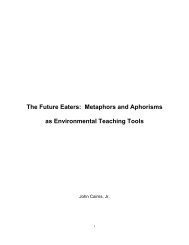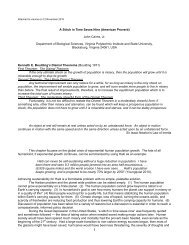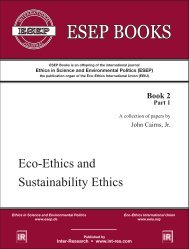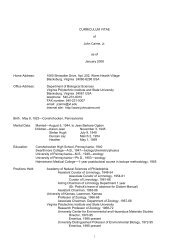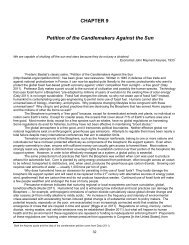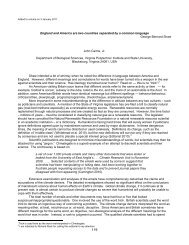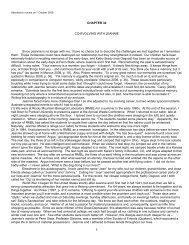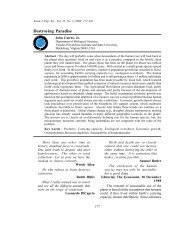View - ResearchGate
View - ResearchGate
View - ResearchGate
Create successful ePaper yourself
Turn your PDF publications into a flip-book with our unique Google optimized e-Paper software.
294Cairns: Eco-Ethics and Sustainability EthicsSacrednessIf Earth were regarded as holy, there would be more impetus to the quest for sustainabilitybecause the ecological life-support system would be regarded as sacred. Everything possiblewould be done to avoid profaning it.ECO-ETHICALLY DRIVEN SUSTAINABLE USE OF THE PLANETIf there were increased literacy and a reverent and sacred attitude toward natural systems, thensome straightforward steps that could be implemented immediately:(1) Renewable resources would only be used at rates that ensure they would remain intact.Fisheries would not be over harvested, ground water aquifers would not be used at greater thanrecharge rates, and areas with depleted natural capital would be ‘rested’ until the natural capitalcould be restored.(2) Ecological restoration would be carried out at rates at least equal to the rates of ecologicaldamage. This view sounds utopian, but ecological destruction must stop sometime, why notnow before nature’s sanctions that enforce carrying capacity limits become very obvious? Still, aneven more utopian idea is that economic/technological strategies, both extremely new in evolutionarytime, will work despite a growing population and increased per capita material affluence. However,ecological restoration is often more swift than ecological restoration. Ecosystems can bedamaged in hours, e.g. by oil spills and other hazardous materials; however, restoring damagedecosystems may take years, decades, or centuries, and even then they may not resemble the predisturbancecondition. Case histories of restoration sites furnish clear evidence of local civic pride inrestoration efforts (National Research Council 1992). Ecological restoration is a global need that isthe aggregation of local, regional, or national damage to ecosystems. However, effective solutionsmust occur at the local level, otherwise the integrity of the restored ecosystem will not be protected.(3) Ecological restoration must be primarily local or regional. Berry (1989) believes that limitsexist to the ability to comprehend and, thus, coordinate entities beyond a certain scale. He furtherasserts that humankind has a limited sense of good and any willingness to do it. How, then, will aconstituency for ecological restoration develop? At present, at least half the planet’s population livesin urban or suburban areas where frequent contact with natural systems is usually quite difficult.Persons who have become disengaged from nature must somehow become re-engaged — if notphysically, then at least spiritually. Redclift (1987) believes that humankind must embrace the waysin which indigenous peoples structure their knowledge of their environment. Both the Natural StepProgram (Robèrt et al. undated) and concepts of natural capitalism (Hawken et al. 1999) offer hopein this regard. A single model does not fit all ecoregions, and sustainable use of the planet requiresboth preservation and accumulation of natural capital, as well as the ecological and cultural practicesthat foster preservation and accumulation. Lovins and Lovins (1982) recommend using ecologicalconcepts for the design of resilient technological systems. Both ecological and technologicalresilience is predicated upon the capacity to withstand both external disturbances and internal malfunctions.Ecological systems retaining resilience are not efficient as the term is used in modernindustrial society (e.g. functional redundancy is common in self-regulating systems).THE IMPORTANCE OF A SENSE OF PLACEA strong sense of place and a reverence for local or regional natural systems is also mandatoryfor sustainable use of the planet. Developing a long-term commitment to the preservation of an



